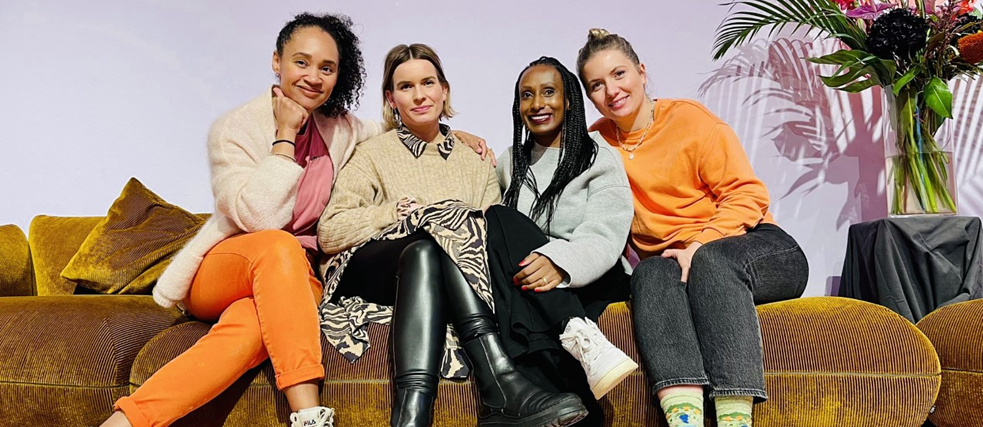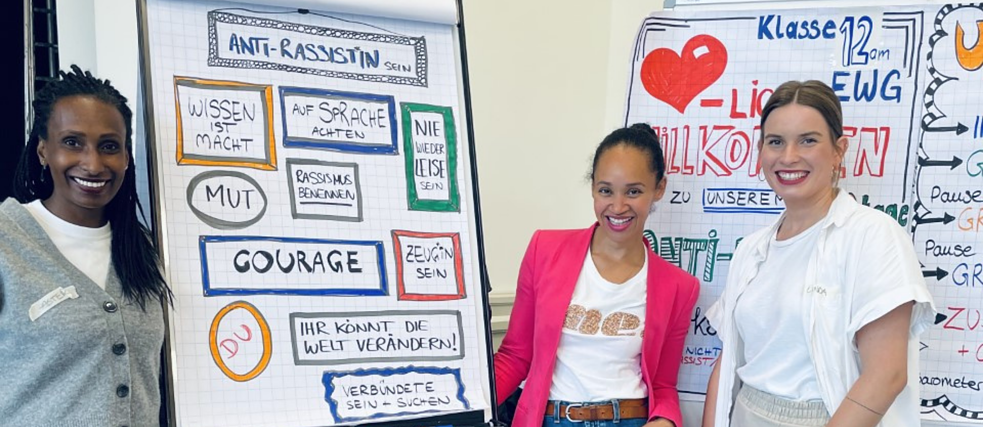Racist language at school
‘Language creates reality’

In many schools, discriminatory language is commonplace. The activists of the Hamburg-based initiative We A.R.E. don't want to put up with it any longer. In an interview, they explained to our author what racist language does to children.
By Sandra Hermes
The Hamburg-based initiative We A.R.E. (“We for Anti-Racism Education”) wants to ensure that children no longer have to experience racism in everyday life. The activists Griselda Welsing (40), Linda Schulz (34), Aster Oberreit (43) and Kira Römer (34) are sure that linguistic education in kindergartens and schools is the key to an education critical of racism. ‘Language creates reality,’ says Linda. ‘It has the power to hurt, to depict one reality of life and to exclude others.’ As a mother of two and an aspiring special-needs teacher, at We A.R.E. Linda is a strong advocate for diverse children's and school books that quite naturally include people with different skin colours, religions or physical abilities. And not in stereotypical roles, such as black athletes or Muslim cleaners, but as doctors, politicians, or carpenters.
Accepting linguistic racism is also a form of discrimination
‘Children who are directly affected by discriminatory language often feel inadequately represented at school,’ explained her fellow campaigner Griselda to me in our interview. The majority of classmates and teachers are usually white (In writing the terms white (italics) and Black (capitalisation), the author follows the recommendation of Amnesty International). There is a lack of role models who are also People of Colour (PoC) and who show the students that they can become anything that white children can become. This includes teachers. ‘Hopefully the next generation of teachers can help PoC feel more seen in school,’ Griselda hopes. She emphasises that linguistic racism in our schools is not limited to deliberately shouting swear words or still using phrases and nursery rhymes with colonial origins. It is also about how others react to it. It is about how those affected are often silenced by the speechlessness of fellow students or teachers. Here, We A.R.E. sees the responsibility especially with the teachers and the school administration. ‘Someone has to say loud and clear that this is not OK, that this language is hurtful. That is incredibly important,’ Griselda explains. Because any failure to respond means tacit approval for the children affected, which further erodes their self-esteem.Social media as a blessing and a curse
In this regard, social media have a special significance. ‘They are a blessing and a curse,’ according to Griselda. Those affected can use it to network and to get support, but it can also be abused quite easily to further spread racist language, hate, and violence. That is why it is so important that there are clear rules for the use of social media in everyday school life, and that class chats should absolutely be moderated by teachers.Reliable structures are needed, the activists of We A.R.E. demand. If in our society someone steals and is caught, this would have clear consequences. If someone racially insults a pupil in the schoolyard or bullies them in a class WhatsApp group, many schools lack clear consequences and clear contact persons, for example anti-discrimination officers. ‘Most of those affected and their parents don't know that there are anti-discrimination bodies and counselling services, especially in big cities and even at the federal level, and this needs to be better communicated,’ Linda criticises.
What each of us can do
We A.R.E. hopes this will be different in a few years. The initiative, founded in 2020, wants to start with the very youngest children in the kindergarten and show them that our society is diverse and that all children are equally valuable, regardless of how they are, how they look, how they think, or how they feel.The more children there are who learn at home and in kindergarten that it was a crime that the indigenous population of America was driven out or killed by European immigrants, the more primary school children learn that people are not better or worse if they sport an Afro, have red hair or fancy the same sex, the more children will later have the courage in the schoolyard to come to the aid of a child who is discriminated against through language or actions.
 The We A.R.E. activist are mainly active in the wider Hamburg area.
| Photo (detail): Tina Weggler © We A.R.E
Together with the other women from We A.R.E., Griselda and Linda go to schools to give age-appropriate anti-racism workshops. Usually, they are not invited by the school administration, but by individual, committed teachers. ‘It would be nice if politicians showed more initiative as well,’ Griselda reckons. At the moment, a lot of work is done by individual activists at the grassroots level. ‘We need these activists, we need those who push forward, who draw attention to the circumstances and abuses. But to have someone from the top saying, I'll pave the way for you, then you can move faster on this important issue, that would be great!’
The We A.R.E. activist are mainly active in the wider Hamburg area.
| Photo (detail): Tina Weggler © We A.R.E
Together with the other women from We A.R.E., Griselda and Linda go to schools to give age-appropriate anti-racism workshops. Usually, they are not invited by the school administration, but by individual, committed teachers. ‘It would be nice if politicians showed more initiative as well,’ Griselda reckons. At the moment, a lot of work is done by individual activists at the grassroots level. ‘We need these activists, we need those who push forward, who draw attention to the circumstances and abuses. But to have someone from the top saying, I'll pave the way for you, then you can move faster on this important issue, that would be great!’What about me? Can I do more? Definitely! Educate myself, read, take a more self-critical look at our language together with my children, don't talk about “colourful” but about “diverse” (as Linda enlightened me), continue to support my children according to their age, and confront the school with any incident, as Griselda recommends. So that racism is visible and the school also gets the chance to react and to help those affected. Because I am just as clear about one thing as Linda and Griselda: as long as there is racism in society, there will also be racism in schools.
As long as the white-majority society does not sensitise children to racist language and stereotypes, nothing will change. Because racist language also influences the views of children who are not directly affected. How? By considering it normal and therefore often not even noticing when it offends their classmates. And by reproducing racism. ‘Just because racism is not the reality of one's own life does not mean it is none of your business,’ Griselda emphasises. ‘And,’ as Linda explains, ‘it is much harder to unlearn prejudices and concepts once you've learned them than to have never learned them at all.’
Griselda's daughter will start school in two years. She wants her daughter to be in a class with children who grew up like Linda's: with a mum who gives them words to stand up against racism.
Literature recommendations:
Apraku, Josephine (2021): Wie erkläre ich Kindern Rassismus? Rassismussensible Begleitung und Empowerment von klein auf, Berlin: familiar faces.Cuff-Schöttle, Stephanie (2020): “Rassismuskritische Praxis von Kinderbeinen an”, in: KiTa aktuell spezial, 2.
Gümüşay, Kübra (2020): Sprache und Sein, Berlin: Hanser Berlin.
KleinePause-Podcast, #31: “Rassismuskritik im Schulsystem und diskriminierungssensible Pädagogik” – with Florence Brokowski‑Shekete.
Marmer, Elina (2013): “Rassismus in deutschen Schulbüchern am Beispiel von Afrikabildern”, in: ZEP – Zeitschrift für internationale Bildungsforschung und Entwicklungspädagogik, 36, 2, 25–31.
Madubuko, Nkechi (2020): Empowerment als Erziehungsaufgabe, Münster: Unrast‑Verlag.